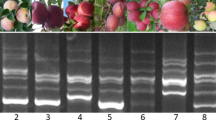Abstract
Anthocyanins are flavonoid pigments imparting red, blue, or purple pigmentation to fruits, flowers and foliage. These compounds are powerful antioxidants in vitro, and are widely believed to contribute to human health. The fruit of the domestic apple (Malus x domestica) is a popular and important source of nutrients, and is considered one of the top ‘functional foods’—those foods that have inherent health-promoting benefits beyond basic nutritional value. The pigmentation of typical red apple fruits results from accumulation of anthocyanin in the skin. However, numerous genotypes of Malus are known that synthesize anthocyanin in additional fruit tissues including the core and cortex (flesh). Red-fleshed apple genotypes are an attractive starting point for development of novel varieties for consumption and nutraceutical use through traditional breeding and biotechnology. However, cultivar development is limited by lack of characterization of the diversity of genetic backgrounds showing this trait. We identified and cataloged red-fleshed apple genotypes from four Malus diversity collections representing over 3,000 accessions including domestic cultivars, wild species, and named hybrids. We found a striking range of flesh color intensity and pattern among accessions, including those carrying the MYB10 R 6 allele conferring ectopic expression of a key transcriptional regulator of anthocyanin biosynthesis. Although MYB10 R 6 was strongly associated with red-fleshed fruit among genotypes, this allele was neither sufficient nor required for this trait in all genotypes. Nearly all red-fleshed accessions tested could be traced back to ‘Niedzwetzkyana’, a presumed natural form of M. sieversii native to central Asia.


Similar content being viewed by others
Abbreviations
- USDA:
-
United States Department of Agriculture
- CCG:
-
Canadian Clonal Genebank
- MSU:
-
Michigan State University
- NFC:
-
National Fruit Collection
References
Andersen OM, Jordheim M (2005) The anthocyanins. In: Andersen OM, Markham KR (eds) Flavonoids: chemistry biochemistry and applications. CRC Press, Boca Raton, pp 471–552
Arthur JM (1936) Radiation and anthocyanin pigments. In: Duggar BM (ed) Biological Effects of Radiation Vol I. McGraw-Hill, New York, pp 471–552
Davies KM (2009) Modifying anthocyanin production in flowers. In: Gould K, Davies K, Winefield C (eds) Anthocyanins: biosynthesis functions and applications. Springer, New York, pp 471–552
Espley RV, Hellens RP, Putterill J et al (2007) Red colouration in apple fruit is due to the activity of the MYB transcription factor, MdMYB10. Plant J 49:414–427
Espley RV, Brendolise C, Chagné D et al (2009) Multiple repeats of a promoter segment causes transcription factor autoregulation in red apples. Plant Cell 21:168–183
Faragher JD (1983) Temperature regulation of anthocyanin accumulation in apple skin. J Exp Bot 34:1291–1298
Fiala Fr JL (1994) Flowering crabapples: the genus Malus. Timber Press, Portland
Harborne JB (1996) The evolution of flavonoid pigments in plants. In: Swain T (ed) Comparative photochemistry. Academic Press, London, pp 271–295
Hatier J-HB, Gould KS (2009) Anthocyanin function in vegetative organs. In: Gould K, Davies K, Winefield C (eds) Anthocyanins: biosynthesis functions and applications. Springer, New York, pp 1–20
Jefferson RM (1970) History, progeny and locations of crabapples of documented authentic origin. National Arboretum contribution, No. 2. Agricultural Research Service, US Dept of Agriculture, Washington DC
Lin-Wang K, Bolitho K, Grafton K et al (2010) An R2R3 MYB transcription factor associated with regulation of the anthocyanin biosynthetic pathway in Rosaceae. BMC Plant Biol 10:50
Lotito SB, Frei B (2006) Consumption of flavonoid-rich foods and increased plasma antioxidant capacity in humans: Cause, consequence or epiphenomenon? Res Radical Biol Med 41:1727–1746
Mulabagal V, van Nocker S, Dewitt D, Nair M (2007) Cultivars of apple fruits that are not marketed with potential for anthocyanin production. J Agric Food Chem 55:8165–8169
Sando CE (1937) Coloring matters of Grimes Golden, Jonathan, Stayman and Winesap apples. J Biol Chem 117:45–56
Sekido K, Hayashi Y, Yamada K et al (2010) Efficient breeding system for red-fleshed apple based on linkage with S3-RNase allele in ‘Pink Pearl’. HortSci 45:534–537
Siegelman HW, Hendricks SB (1952) Photocontrol of anthocyanin synthesis in apple skin. Plant Physiol 33:185–190
Steyn WJ (2009) Prevalence and functions of anthocyanins in fruits. In: Gould K, Davies K, Winefield C (eds) Anthocyanins: biosynthesis functions and applications. Springer, New York, pp 85–105
Telias A, Bradeen JM, Luby JJ et al (2010) Regulation of anthocyanin accumulation in apple peel. In: Janick J (ed) Horticultural Reviews, vol 38. John Wiley & Sons Inc, Hoboken, pp 357–391
USDA, ARS, National Genetic Resources Program (2011) Germplasm Resources Information Network (GRIN), (Online Database). National Germplasm Resources Laboratory, Beltsville. Available: http://www.ars-grin.gov/cgi-bin/npgs/html/crop.pl?115 (17 February 2011)
Acknowledgments
We thank Jeff Wilson (MSU Campus Planning and Administration) and Dr. Frank Telewski (MSU Department of Plant Biology and MSU Campus Planning and Administration) for assistance with locating Malus accessions within the MSU campus. We acknowledge the assistance of Tyler Harris, MSU Multicultural Apprentice Program, with fruit collection and processing and Mary Pennell (NFC Horticultural Curator). This work was supported by the Michigan Apple Commission, the Michigan Department of Agriculture (Grant No. 791N0200091), and the Education Foundation of the American Society of Plant Biologists.
Author information
Authors and Affiliations
Corresponding author
Electronic supplementary material
Below is the link to the electronic supplementary material.
Rights and permissions
About this article
Cite this article
van Nocker, S., Berry, G., Najdowski, J. et al. Genetic diversity of red-fleshed apples (Malus). Euphytica 185, 281–293 (2012). https://doi.org/10.1007/s10681-011-0579-7
Received:
Accepted:
Published:
Issue Date:
DOI: https://doi.org/10.1007/s10681-011-0579-7




